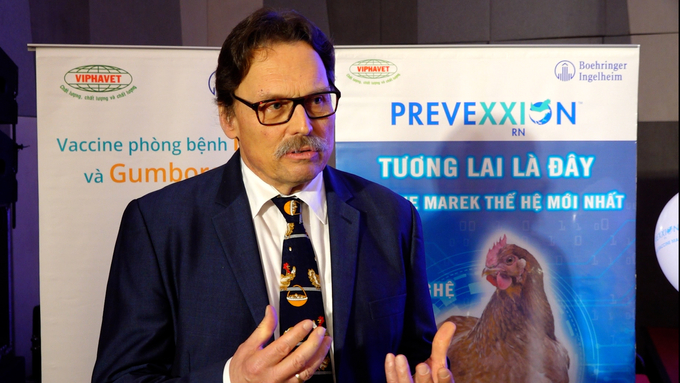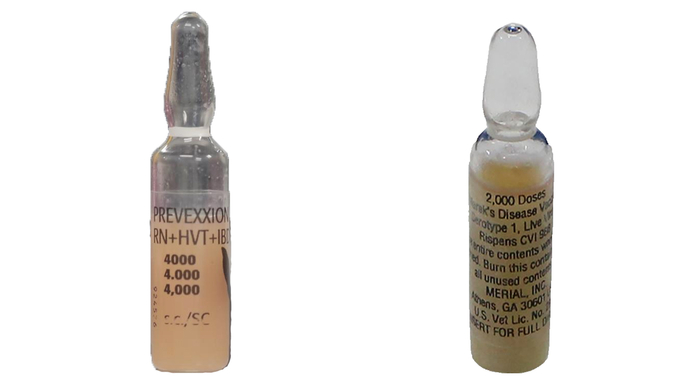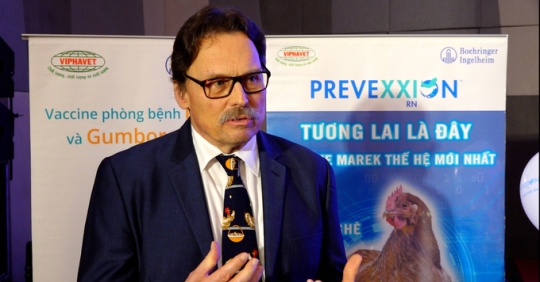Marek’s disease virus was first discovered in 1907 by Hungarian pathologist Jozsef Marek.
After more than a century, Marek is still a problem for poultry farmers not only in Vietnam but all over the world, due to the rapid spread of the disease, the incidence rate is between 10% and 60%, the mortality rate can reach 100%. because there is no specific treatment.
Marek is an infectious disease of chickens caused by a virus of the herpes group. The disease is characterized by a proliferation of lymphocytes in the form of tumors in peripheral nerves, internal organs, skin and muscles, causing symptoms of movement disorders and paralysis.

Professor Andreas Herrmann, Global Technical Director, Boehringer Ingelheim Company. Picture: Quang Linh.
This was shared by Professor Andreas Herrman, Technical Director Global, Boehringer Ingelheim, at the Vaxxitek Refresh Prevexxion – The future of Marek Vaccines conference organized by Viet Phap International Co., Ltd – VIPHAVET on April 12 in Ho Chi Minh City and on April 14 in Hanoi with The current Marek’s disease virus in the environment has very high dynamics when virus strains mutate for a long time, classic vaccines developed by cell culture technology do not. It is also highly effective when protection is reduced after each infusion to ensure safety.
In particular, today’s Marek’s disease spreads faster, but is also more difficult to detect.

Prevexxion RN vaccine (left) and RISPENS CVI988 vaccine (right). Picture: Quang Linh.
In order to meet the market demand for a vaccine that ensures both safety and efficacy, the Prevexxion RN vaccine provided by Boehringer Ingelheim Vietnam Veterinary Medicine Company is developed using genetic engineering and offers many outstanding advantages compared to classical vaccines, such as: Virulent virus strains, fast and stable effectiveness, no atrophy of the immune organs, no paralysis, etc.
Prevexxion RN is the breakthrough technology of Marek’s vaccine, not just panicles, SB1 or HVT. Prevexxion is a hybrid virus composed of 83% of the original CVI988 combined with the Md5 and RM1 genes of the Marek virulence lineage stabilized by gene insertion in LRT, therefore Prevexxion RN is also known as the mosaic vaccine.
Chickens immunized with Prevexxion RN showed no lesions, no clinical signs and safe results, reduced shedding and no immunosuppression.
Prevexxion RN remained safe, stable and caused no lesions after 6 generations of chickens and did not recover after 5 subcultures in SPF chickens. Meanwhile, classic vaccines such as RISPENS CVI988 showed MD lesions in 1 chicken at the 3rd reverse transfer.

Chicken farm in Quang Ngai using Prevexxion RN vaccine has a survival rate of over 99%. Picture: Quang Linh.
During its use in Vietnam, the Prevexxion RN vaccine protects chickens well, no symptoms of Marek’s disease were detected during the surveillance process, vaccination did not affect performance and the production of immunity to diseases such as Newcastle disease or Newcastle disease Gumboro and it there is no risk of subsequent release into the environment.
Also at the workshop Vaxxitek Refresh Prevexxion – The Future of Marek Vaccines, Ms Nguyen Thi The, owner of a De Heus Group white chicken farm in Nam Dinh using the Vaxxitek vaccine, shared that she herself refuses to use the Vacxxitek To use vaccine thought that this vaccine is only used for colored chickens and in the short term white chickens do not need to be used.
“One day chickens on my farm got scabies and were found to be infected with Marek’s disease. Then we decided to vaccinate the 1 day old chickens with Vaxxitek. The results were very surprising, the chickens that were injected grew evenly, the polio rate is low, the consumption of bran is low, etc. In particular, some farms had scabies before vaccination, and now this disease has not recurred,” added Ms The added.
According to Mr. Nguyen Van Trong, former deputy director of the Livestock Department, chickens infected with Marek often leave consequences such as high mortality, slow growth, poor meat quality and uneven development of the rearing chickens, poor laying rate, eggs with embryos and hatch rate are low , Feed and veterinary costs are very high, it is difficult to deal with the environment in the yard.

Mr. Nguyen Van Trong, Former Deputy Director of Livestock Department. Picture: Quang Linh.
Mr. Nguyen Van Trong said that the application of Prevexxion RN vaccine will open a new direction for household rearing to remotely prevent Marek’s disease in chickens. Not only will this ensure disease safety, but it will also provide consumer confidence in safe, high-quality meat products in a context where the livestock industry is under a lot of pressure when prices are falling, production costs are low, production costs are rising, the big Competition from imported products is high.
With the livestock industry facing many difficulties today, livestock households must be proactive in epidemic prevention. It’s also a way to reduce production costs if they don’t need to destroy, disinfect and separate the flock due to infection Strongly recommended.
According to a study by the Department of Veterinary Medicine of the National Agricultural Academy of Vietnam, the clinical signs of Marek’s disease are summarized with three main manifestations, including: neurological manifestations, sick chickens lying down, eye manifestations and skin tumors.
Neurological manifestations: Indeed, because of the slow progression of the disease on the nervous system, the neurological manifestations are often not prominent, but the neurological manifestations are very characteristic.
With symptoms of chicken paralysis or paraplegia, the chicken initially moves slightly, the toes are clenched, the chicken flaps its wings, staggers unsteadily. When severely ill, chickens are completely paralyzed and lie in a typical position: one leg stretched forward, the other leg stretched back.
Symptoms of Slumbering Sick Chickens: Sick chickens are cranky, disheveled, and winged. If there is a tumor in the chicken’s lungs, it will be difficult to breathe, it will pass quickly, and the chicken will lose weight quickly.

